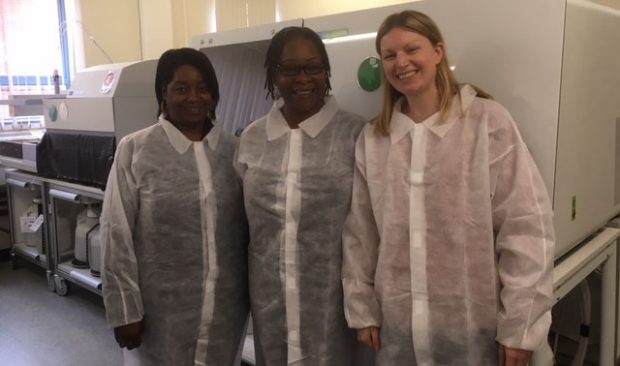My name is Katy and I have worked on the PHE Screening helpdesk for almost 2 years. During that time I have often felt I would like a bit more knowledge about some of the antenatal screening tests.
I would read emails to the helpdesk and send them on to the relevant person to deal with, often wishing I knew a bit more about what they were about.
So it was an easy decision when my line manager asked me if I would like to visit to an antenatal screening laboratory to find out what happens behind the scenes.
I was put in touch with Carolyn Williams, consultant biochemist and director of antenatal screening at the Royal Bolton Hospital, who kindly accepted my request to come and visit their laboratory. I arranged the trip for myself and my fellow helpdesk advisors Marcia Jackson and Linda Harrison.

We started early for the trip from London up to Bolton eager to learn about the world of antenatal screening.
Filling in the gaps
We were met by Carolyn and Karina Hambridge, antenatal screening laboratory manager, who both work in the Antenatal Screening Laboratory of Medicine at Royal Bolton Hospital. They asked what we’d like to get out of the day and we said we were really keen to see how the lab worked and fill in the gaps in our knowledge.
Karina started by showing us the process of dealing with the forms that are sent into the lab. Fully completed forms must accompany all blood samples to make sure calculation of the result is reliable. Boxes for the required screening tests must be ticked and results are only calculated for the conditions ticked on the form.
It was interesting to see the forms and the information included on them. The lab team manually inputs this information into its computer system.
Into the lab
We then headed into the laboratory, wearing snazzy lab jackets. There was a hum of activity in the lab and everyone was immersed in the work.
There were samples being labelled, record cards being scanned, samples being moved into a large refrigerator and chase-up calls being made to obtain information missing on cards.
We were shown the machines which check the samples, one called Rosie, another called Jim, which gives a child of the ’80s a giggle. The samples were tested and we could see the machines working through them.
There was also a smaller machine which can test samples much faster - used for samples that come in urgently for a result. These samples are normally marked urgent on the record card and there is a call from the sample taker to tell the lab it is on its way. The lab records the name for the sample on a whiteboard to make sure it is dealt with quickly when it arrives.
Mission accomplished
All aspects of the laboratory conveyed great team work. Seeing how it all works in practice gave us a much greater understanding of how a fetal anomaly screening programme laboratory works.
We really enjoyed our experience with Carolyn, Karina and the team and we are extremely grateful they took the time out to show us around. We could not have hoped for a better day!
PHE Screening blogs
PHE Screening BLOGs provide up to date news from all NHS screening programmes. You can register to receive updates direct to your inbox, so there’s no need to keep checking for new blogs.